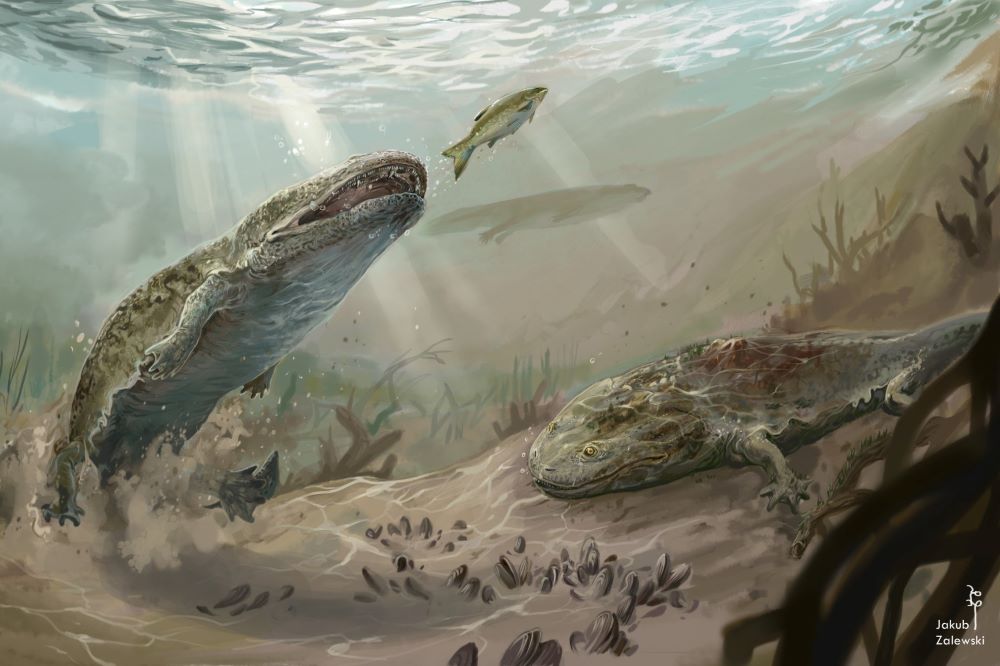Each of 50 Weeks in the City of Science features a text about selected research in a given subject area carried out by scientists from the universities forming the Academic Consortium Katowice City of Science. The texts we publish give insight into the diversity of issues scientists deal with and show the research potential that is dormant in the universities of the consortium.
| Agnieszka Kliks-Pudlik |
The Treasure Week is the Week #2 out of 50 Weeks in the City of Science. During the event, scientists are going to unearth knowledge about rocks, minerals, and fossils.
Metoposaurus, representatives of Labyrinthodontia (Greek, ‘maze-toothed’) in their habitat, about 210 million years ago. The individual on the right has a distinct overgrowth in the anterior thoracic spine. It has limited mobility along with the ability to hunt and seems malnourished. Author of the picture: Jakub Zalewski
‘Without mineral resources, a majority of everyday objects would not have existed. During the Treasure Week, we wish to show that the wealth of a society and its existence is highly dependent on mineral deposits and the advancement of research in this regard,’ says Ewa Głuszek, MSc Eng., one of the curators of the Treasure Week and Head of the Czesław Poborski Museum of Deposit Geology at the Faculty of Mining, Safety Engineering and Industrial Automation of the Silesian University of Technology.
Geological treasures
Different aspects of geology are dealt with by scientists from the Department of Applied Geology at the Faculty of Mining, Safety Engineering and Industrial Automation of the Silesian University of Technology. ‘We study rocks constituting a raw material for road aggregate production, limestone rocks used in the concrete industry and a sorbent for the desulphurisation of flue gases, as well as samples of rocks with metal ores,’ explains Jacek Nowak, PhD Eng.
Geologists scrutinise mineral waste gathered through coal mining, which might be a potential source of raw materials; they also study the waste’s impact on the water and soil environments and seek new methods of its application.
Even though the current trends consider a phase-out of fossil fuels, including coal, they still remain materials that matter. ‘Supposing that the energy industry decides to quit using coal, it will still be used to produce coke, without which it is impossible to make steel. Therefore, studying coal remains an essential scientific task,’ indicates Jacek Nowak, PhD Eng.
Coal—as well as other treasures in the form of raw minerals—needs to be extracted, and thus scientists are constantly developing robotization in underground mining. One such example is a project of a coal harvester simulator, which can be used to train the crew in terms of steering the machine in selected conditions, and monitor the signals emitted by actual machines to inspect their effectiveness. The work is led by Piotr Cheluszka, PhD, DSc Eng., Assoc. Prof., the Silesian University of Technology.
Fossilised treasures
Treasures of the Earth are not only about precious minerals but also about priceless fossils of plants and animals documenting the history of our planet. This area is a specialisation of Dawid Surmik, PhD, from the Institute of Earth Sciences, USil Faculty of Natural Sciences. The team he led to a discovery of cancer found in a bone of a prehistoric amphibian over 210 million years old, proving that cancers—the cause of which used to be linked to environmental pollution—affected prehistoric animals as well.
In another study, Surmik’s team documented that dinosaurs’ tendons underwent the process of ossification, just like those of modern birds. Soft parts of the body, such as collagen, blood vessels and cells, are rarely preserved in the fossils of extinct vertebrates, and palaeontologists were the first to identify them in the tendons of dinosaurs.
Geological heritage
Scientists from the Academic Consortium Katowice City of Science engage in studies on the geological and post-mining heritage. 30 such facilities located near the border of Poland and the Czech Republic are collected in a single mobile app called ‘Silesian Expedition’, co-developed by one of the Week’s curators – Prof. Eng. Małgorzata Labus from the Faculty of Mining, Safety Engineering and Industrial Automation of the Silesian University of Technology.
The full programme is available at us.edu.pl/en/tydzien-skarbow-w-miescie-nauki-8-14-stycznia-2024






